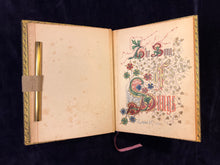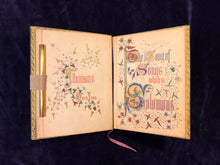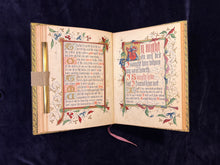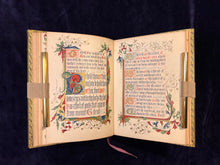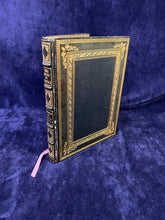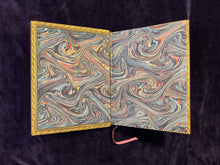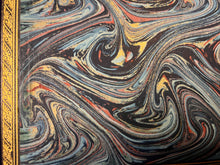
Jones, Owen, The Song of Songs, [London]: Longman & Co. 1849.
FIRST EDITION (160 x 205 mm) ff. 16. Chromolithographed pages, in reds, blues, green, gold, and black, mounted on guards. Rebound in full leather, black, with gold blind tool stamp and gaufers, as well as decorations on spine. Blue marbled pastedown and fly leaf. Some foxing, minor hinge trauma not effecting sturdiness. Overall GOOD to VERY GOOD condition.
The Victorians had a thing for the Middle Ages, there’s no doubt about it. While some artists sought the ruined abbeys & castles as inspiration for their dark, gothic works; others dug for the roots of their national identity in convoluted histories such as the legends of King Arthur; &, others still looked to the lighter and brighter sumptuously illuminated manuscripts as worthy of recreation in their own image. Owen Jones, one of the foundational figures in the important printing style of chromolithography & creations of medievalism, wrought his imagery from 13th-15th century Gothic French & Flemish illuminations, weaving acanthus & ivy leaves around the borders. The blue and red pen flourishes that act as line fillers range from medieval mimicry to patterns that look like they were produced by someone who had a medieval manuscript described to them. The large, illuminated initials are also something fresh, from the Victorian mind. While medieval manuscripts used red letters or words to indicate section breaks, the rubricated words in text are seemingly at random, drawing the eye across the page for aesthetics rather than function. In the same way that ornate medieval manuscripts served as a method of conspicuous consumption for the increasingly upwardly mobile classes in the 13th -15th centuries, Owen Jones luxury-book occupies the same cultural space for the upper-class consumer in Victorian England.
* Chromolithography uses a separate stone to imprint each color used; therefore Jones’ Song of Songs would have been produced using at least seven separate printing processes. Chromolithography is the flamboyant sibling of black-and-white lithography.
MB273







